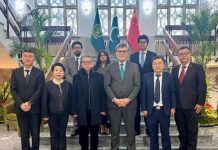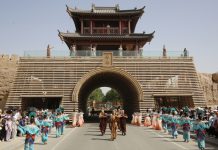Beijing: Putting minuscule flakes of paint back on a painting more than 1,000 years ago. Inspecting a cave that has been around for a millennium for fungal and other infections. Restoring tiny fragments on a stone wall dating back to the Tang Dynasty (618-907).
These are some of the tasks Su Bomin, a “doctor” of murals, does daily during his round of the famous Dunhuang murals, the Buddhist wall paintings on hundreds of grottoes in Dunhuang, Gansu Province, thought to have been created between the 4th and 14th centuries on the Gobi Desert.
“The longer I work here, the stronger my connection to the cultural relics becomes. I now have a special feeling for them,” Su, Director of the Department of Conservation and Research, the Dunhuang Academy China, which oversees the Mogao Caves, told Beijing Review. He has been working in the caves for 29 years.
Humans create works of art to embody their civilizations. But none of it can be preserved physically forever. Some are destroyed by natural disasters, some by war and some by time. But when technology is harnessed to ancient civilization, the results of the collaboration can withstand the ravages of time and protect heritage sites and cultural relics.
Digital database
Dunhuang used to be a strategic point along the ancient Silk Road and traces of exchanges between different civilizations can be found in the mottled murals and Buddhist statues of the iconic Mogao Grottoes.
A UNESCO World Heritage Site, the caves, also known as the Caves of a Thousand Buddhas, host a treasure trove of Buddhist art, including more than 2,000 colored sculptures and 45,000 square meters of frescoes in 735 caves. Their historical and religious value is incomparable.
“When I first came to Dunhuang in 1992, I took a train from Lanzhou in Gansu. The trip lasted 28 hours. When I got off the train, I saw wilderness all around,” Su described his first impression of Dunhuang. “The road was carved through the Gobi Desert, creating a sense of desolation. What could I do here? I thought.”
But his hesitation disappeared when the Dunhuang Academy began to collaborate with institutions in the United States, Japan and other countries in the late 1980s. In particular, the research on the protection of the No.85 cave with the Getty Conservation Institute in the U.S. in 1997 has become a model in cultural heritage protection.
The cooperation has given Su exposure to international advanced concepts such as preventive protection and made him feel more and more strongly that science and technology can do great things in the protection of cultural relics.
“The preservation of cultural relics is a multidisciplinary task, which needs chemistry, physics, materials science and more. Also, it is not simply an act of repairing. We must maintain the authenticity,” Su said. “We need to figure out things like how water affects the caves; what kind of changes in the environment can cause the murals to disintegrate.”
To preserve them, the frescoes have been digitalized. The Dunhuang Academy launched a preservation project, Digital Dunhuang, and in 2016, the first phase of the Digital Dunhuang resource database went online. People from all over the world can enjoy high-definition images and panoramic tours of 30 caves on the Digital Dunhuang website, which shows a new cultural relic protection philosophy.
In 2017, Chinese tech giant Tencent cooperated with the Dunhuang Academy for the digital development of the cultural industry. Digital Dunhuang integrates videos, 3D data and images to create a digital repository of the cultural relics of the caves that can be shared globally over the Internet. Wearing virtual reality glasses, visitors are transported to a breathtaking virtual Dunhuang grotto. The online presentation allows more people access to the heritage site while helping reduce visitor numbers at the caves.
Expanding the scale
Technological protection and immersive digital experiences are being offered for other heritage sites as well. Thanks to technology, the over 1,500-year-old Yungang Grottoes in Shanxi Province were brought to life in Shanghai’s Powerlong Museum last year, more than 1,000 km away from the caves. It was a one-to-one scale presentation of Yungang’s No.12 cave, made possible by 3D scanning and printing technology.
The Yungang Grottoes are one of the three major repositories of ancient Buddhist art, along with the Mogao Caves and the Longmen Grottoes in Luoyang, Henan Province.
“Today’s 3D printing technology enables us to reduce the margin of error to the millimeter level. We recreated this 20-meter-high cave, where the differences in details from the original were kept under 2 mm,” Zhang Zhuo, Director of Yungang Grottoes Research Institute, told ThePaper.cn.
Digital technology has also brought ancient grottoes, scattered across the country, together in one place. The first joint exhibition of China’s three major grottoes was digitally showcased in Luoyang on October 18 last year.
The exhibition broke the space barrier of these immovable cultural relics, displaying their exquisite carvings and paintings, their rich history as well as the protection of cultural heritage with 3D printing, virtual reality and other digital technologies.
Dunhuang was an open city that respected other cultures. For thousands of years, traders speaking different languages came to the city to buy Chinese silk, tea, porcelain and fruits and sell Western gemstones, spices and horses. The paintings in the ancient grottoes reflect the prosperous social and commercial activity. Having witnessed the spread of Buddhism along the Silk Road into China, the grottoes are a testament to the diverse cultural exchanges in world history.
“Dunhuang bridges ancient Chinese, Indian, Greek and Roman and Egyptian civilizations,” Wang Xudong, Curator of the Dunhuang Museum between December 2014 and April 2019, said in a documentary, The Grottoes Corridor of China.
Cultural responsibility
Safeguarding heritage and the wellbeing of people and communities are linked closely, a UNESCO article said on March 11, paying tribute to the tragic destruction of the Bamiyan Buddhas.
The Bamiyan Buddhas destroyed by the Taliban in March 2001, were two giant statues of the Buddha carved on the mountains in Bamiyan Valley in Afghanistan during the 6th century. On June 6, 2015, a Chinese couple, Zhang Xinyu and his wife, Liang Hong, recreated the Buddhas by using special projecting technology.
Even in today’s modern society, the world’s cultural heritage remains under attack from wars, natural disasters, thefts and accidents. Not all damaged or destroyed cultural relics can be recreated with hi-tech.
Heritage sites reflect a nation’s development and wisdom in the past. According to Su, it is conservators’ responsibility to uncover the histories and stories of cultural relics and tell them to future generations as well as ensure the relics are well-protected.
Defending cultural diversity is not a luxury, but fundamental to building more peaceful societies, the UNSCO article said.
Last year, the State Council issued a set of guidelines to enhance protection and studies of China’s grotto temples.
“Grotto temples are widely distributed in China on a large scale, with a complete lineage of development,” the guidelines stated. “They combine architecture, frescoes, sculpture and calligraphy and reflect Chinese people’s aesthetics, values and spirits.” The guidelines emphasize preservation of the sites that show the fine cultural traditions and the values of the Belt and Road Initiative, highlighting communication and mutual learning among civilizations.
“I hope even after 1,000 years, our data can be passed on to the future generations. From the images, colors and all the information we archived they will understand how people who lived on the same soil before them expressed their faith and lives,” Su said.
– The Daily Mail-Beijing Review News exchange item






